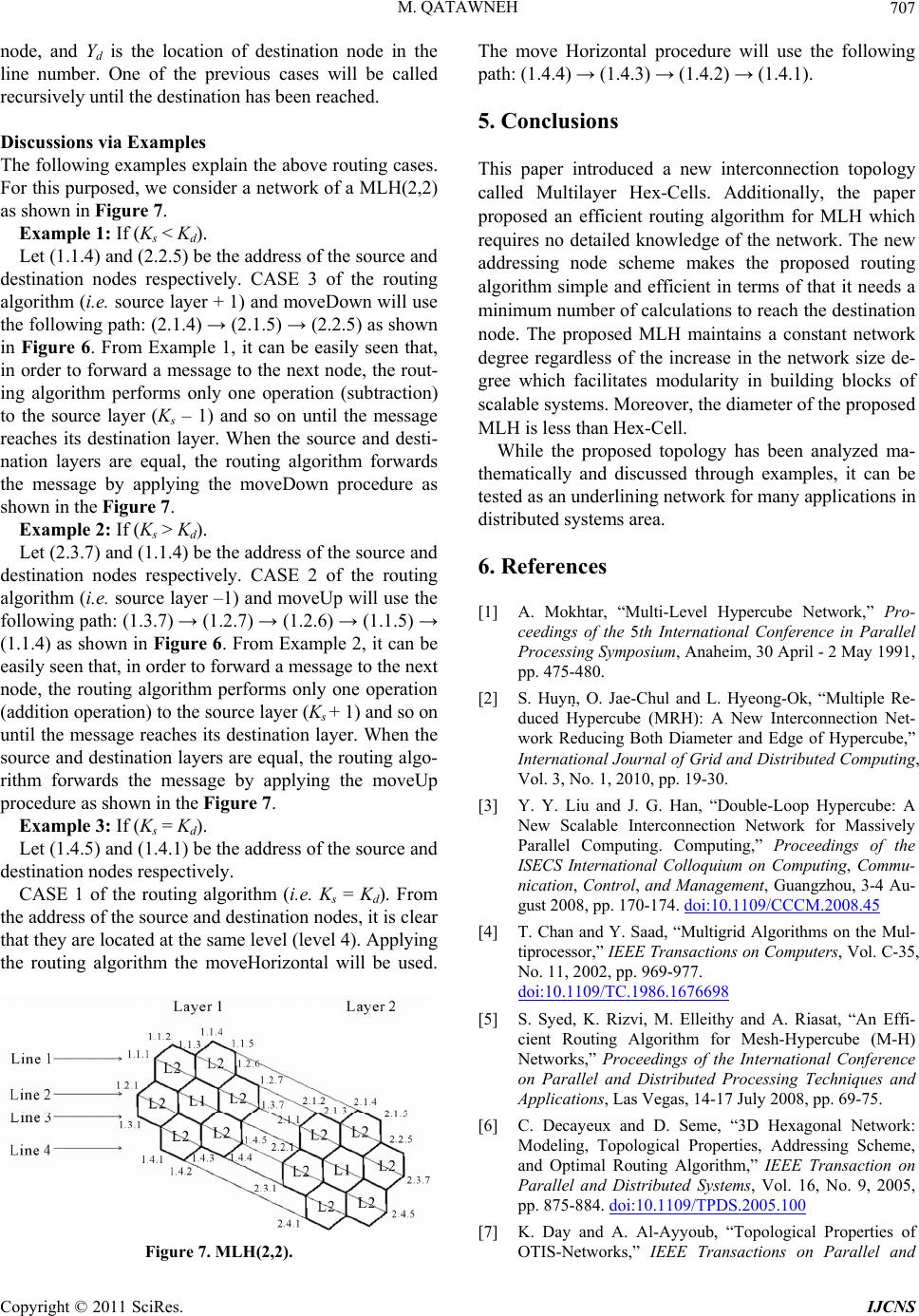
M. QATAWNEH707
node, and Yd is the location of destination node in the
line number. One of the previous cases will be called
recursively until the destination has been reached.
Discussions via Example s
The following examples explain the above routing cases.
For this purposed, we consider a network of a MLH(2,2)
as shown in Figure 7.
Example 1: If (Ks < Kd).
Let (1.1.4) and (2.2.5) be the address of the source and
destination nodes respectively. CASE 3 of the routing
algorithm (i.e. source layer + 1) and moveDown will use
the following path: (2.1.4) → (2.1.5) → (2.2.5) as shown
in Figure 6. From Example 1, it can be easily seen that,
in order to forward a message to the next node, the rout-
ing algorithm performs only one operation (subtraction)
to the source layer (Ks – 1) and so on until the message
reaches its destination layer. When the source and desti-
nation layers are equal, the routing algorithm forwards
the message by applying the moveDown procedure as
shown in the Figure 7.
Example 2: If (Ks > Kd).
Let (2.3.7) and (1.1.4) be the address of the source and
destination nodes respectively. CASE 2 of the routing
algorithm (i.e. source layer –1) and moveUp will use the
following path: (1.3.7) → (1.2.7) → (1.2.6) → (1.1.5) →
(1.1.4) as shown in Figure 6. From Example 2, it can be
easily seen that, in order to forward a message to the next
node, the routing algorithm performs only one operation
(addition operation) to the source layer (Ks + 1) and so on
until the message reaches its destination layer. When the
source and destination layers are equal, the routing algo-
rithm forwards the message by applying the moveUp
procedure as shown in the Figure 7.
Example 3: If (Ks = Kd).
Let (1.4.5) and (1.4.1) be the address of the source and
destination nodes respectively.
CASE 1 of the routing algorithm (i.e. Ks = Kd). From
the address of the source and destination nodes, it is clear
that they are located at the same level (level 4). Applying
the routing algorithm the moveHorizontal will be used.
Figure 7. MLH(2,2).
The move Horizontal procedure will use the following
path: (1.4.4) → (1.4.3) → (1.4.2) → (1.4.1).
5. Conclusions
This paper introduced a new interconnection topology
called Multilayer Hex-Cells. Additionally, the paper
proposed an efficient routing algorithm for MLH which
requires no detailed knowledge of the network. The new
addressing node scheme makes the proposed routing
algorithm simple and efficient in terms of that it needs a
minimum number of calculations to reach the destination
node. The proposed MLH maintains a constant network
degree regardless of the increase in the network size de-
gree which facilitates modularity in building blocks of
scalable systems. Moreover, the diameter of the proposed
MLH is less than Hex-Cell.
While the proposed topology has been analyzed ma-
thematically and discussed through examples, it can be
tested as an underlining network for many applications in
distributed systems area.
6. References
[1] A. Mokhtar, “Multi-Level Hypercube Network,” Pro-
ceedings of the 5th International Conference in Parallel
Processing Symposium, Anaheim, 30 April - 2 May 1991,
pp. 475-480.
[2] S. Huyn, O. Jae-Chul and L. Hyeong-Ok, “Multiple Re-
duced Hypercube (MRH): A New Interconnection Net-
work Reducing Both Diameter and Edge of Hypercube,”
International Journal of Grid and Distributed Computing,
Vol. 3, No. 1, 2010, pp. 19-30.
[3] Y. Y. Liu and J. G. Han, “Double-Loop Hypercube: A
New Scalable Interconnection Network for Massively
Parallel Computing. Computing,” Proceedings of the
ISECS International Colloquium on Computing, Commu-
nication, Control, and Management, Guangzhou, 3-4 Au-
gust 2008, pp. 170-174. doi:10.1109/CCCM.2008.45
[4] T. Chan and Y. Saad, “Multigrid Algorithms on the Mul-
tiprocessor,” IEEE Transactions on Computers, Vol. C-35,
No. 11, 2002, pp. 969-977.
doi:10.1109/TC.1986.1676698
[5] S. Syed, K. Rizvi, M. Elleithy and A. Riasat, “An Effi-
cient Routing Algorithm for Mesh-Hypercube (M-H)
Networks,” Proceedings of the International Conference
on Parallel and Distributed Processing Techniques and
Applications, Las Vegas, 14-17 July 2008, pp. 69-75.
[6] C. Decayeux and D. Seme, “3D Hexagonal Network:
Modeling, Topological Properties, Addressing Scheme,
and Optimal Routing Algorithm,” IEEE Transaction on
Parallel and Distributed Systems, Vol. 16, No. 9, 2005,
pp. 875-884. doi:10.1109/TPDS.2005.100
[7] K. Day and A. Al-Ayyoub, “Topological Properties of
OTIS-Networks,” IEEE Transactions on Parallel and
Copyright © 2011 SciRes. IJCNS